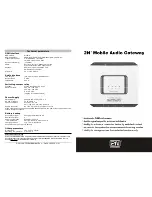
PLC device configuration
6.2 High-speed I/O
S7-200 SMART
168
System Manual, V2.3, 07/2017, A5E03822230-AF
6.2
High-speed I/O
High-speed counters
The CPU provides integrated high-speed counter functions that count high speed external
events without degrading the performance of the CPU. Refer to the "Product overview"
(Page 17) chapter for the rates supported by your CPU. Dedicated inputs exist for clocks,
direction control, and reset, where these functions are supported. You can select single
phase, dual phase, or AB quadrature phase for varying the counting rate. For more
information, refer to the description of the high-speed counter instructions (Page 257).
High-speed pulse output
The standard CPU models support high-speed pulse outputs that generate either a high-
speed pulse train output (PTO) or pulse width modulation (PWM) on certain outputs. Refer to
the "Product overview" (Page 17) chapter for the quantity and rates supported by your CPU.
The PTO function provides a square wave (50% duty cycle) output for a specified number of
pulses (from 1 to 2,147,483,647 pulses) and a specified frequency (in Hz). You can program
the PTO function to produce either one train of pulses or a pulse profile consisting of multiple
trains of pulses. For example, you can use a pulse profile to control a stepper motor through
a simple ramp up, run, and ramp down sequence or more complicated sequences.
The PWM function provides a fixed cycle time with a variable duty cycle output, with the
cycle time and the pulse width specified in either microsecond or millisecond increments.
When the pulse width is equal to the cycle time, the duty cycle is 100 percent, and the output
is turned on continuously. When the pulse width is zero, the duty cycle is 0 percent, and the
output is turned off.
Refer to the pulse output instruction (Page 285) for more information. The chapter on open-
loop motion control provides additional information using PWM (Page 595).
Open-loop motion control
The standard CPU models support an open-loop motion control capability. Motion profiles
can be constructed and executed, interactive movement can be performed under user
program control, and a number of built-in reference point seek sequences are available.
Depending upon configuration, open-loop motion support in the CPU requires the use of
certain CPU resources, such as high-speed outputs, high-speed counters, and edge
interrupts.
Refer to the "Product overview" (Page 17) chapter for the quantity of motion axes and pulse
rates supported by your CPU.
Refer to the chapter on open-loop motion control (Page 595) for a full description of the
motion capabilities in your CPU.
















































